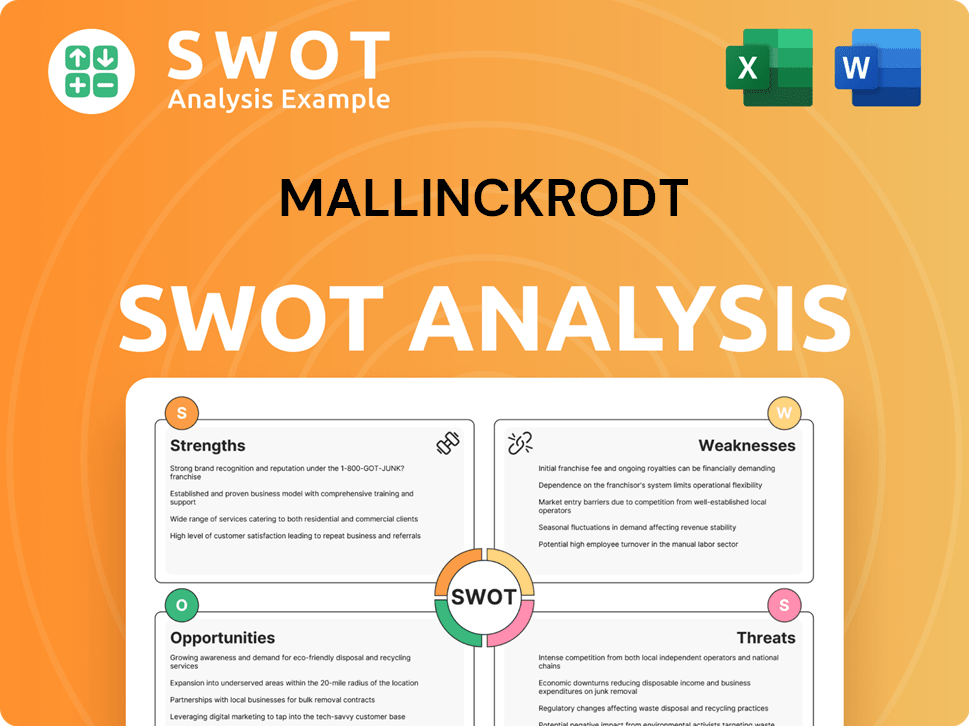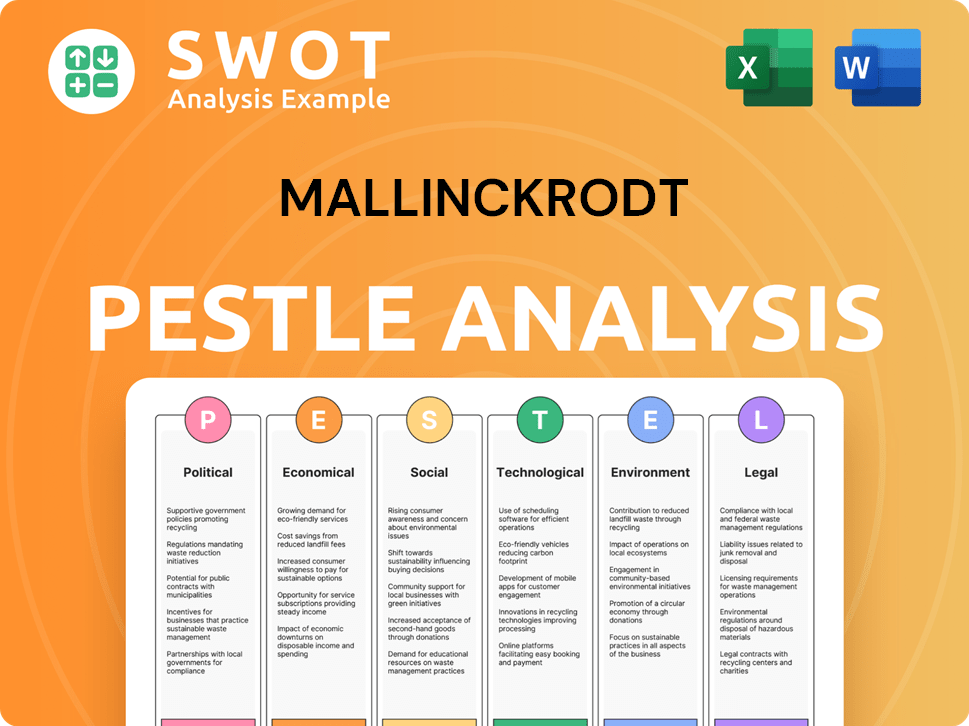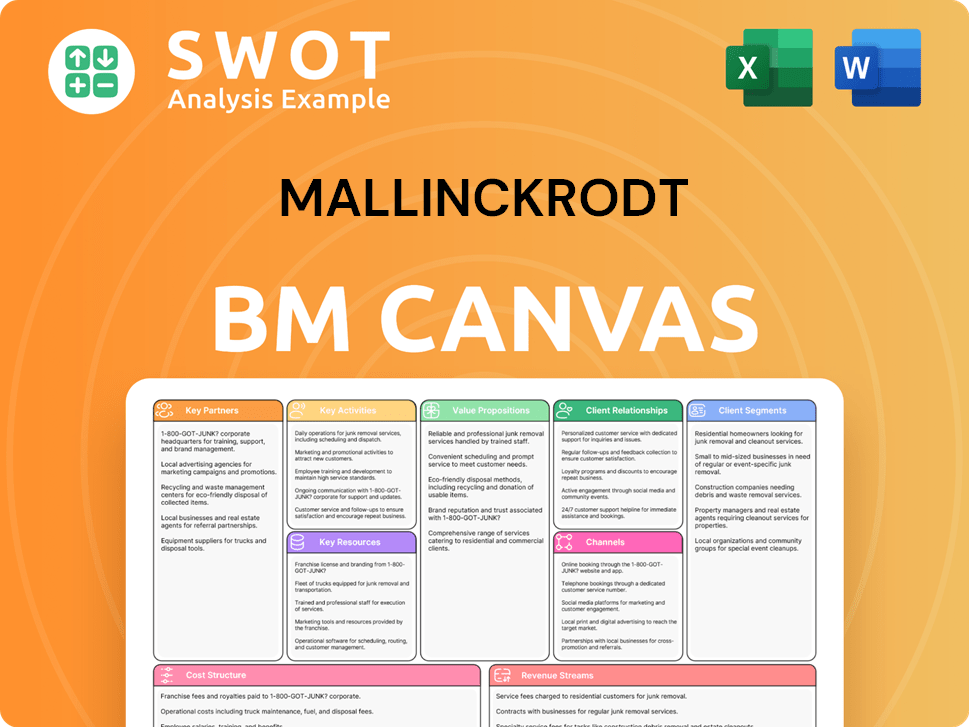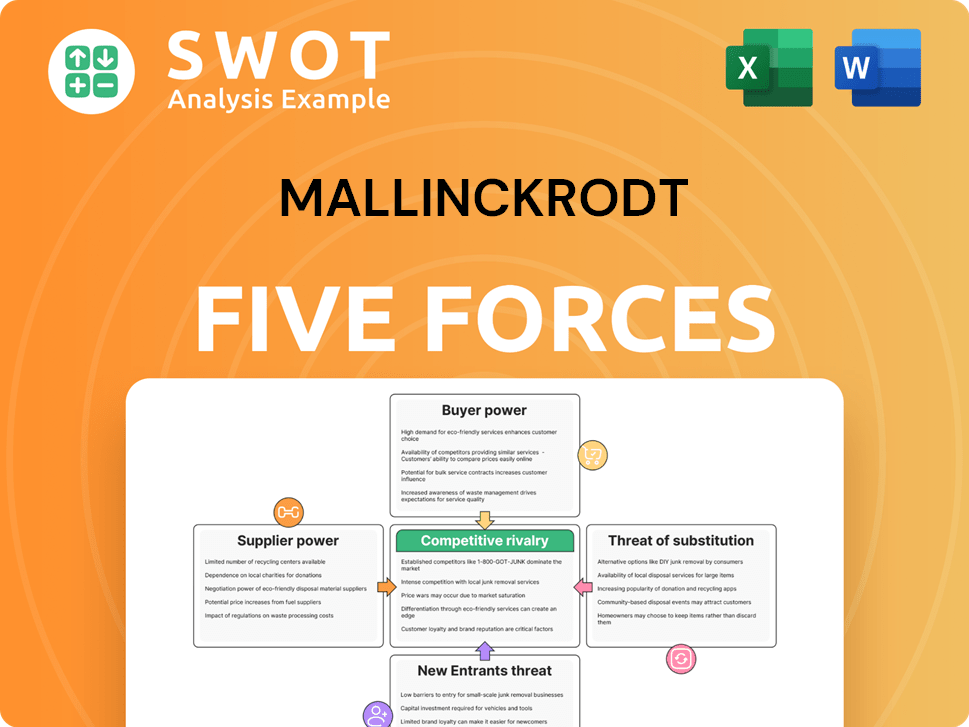Mallinckrodt Bundle
Who Really Owns Mallinckrodt Pharmaceuticals?
Unraveling the Mallinckrodt SWOT Analysis is just the beginning; understanding its ownership is key to grasping its future. The Mallinckrodt company has undergone significant transformations, particularly after emerging from bankruptcy in 2022. Knowing who controls Mallinckrodt dictates its strategic moves and its ability to navigate the complex biopharmaceutical landscape.

This exploration of Mallinckrodt ownership will examine the company's historical evolution, from its roots in 1867 to its current position as a global biopharmaceutical player. We'll dissect the Mallinckrodt company's ownership structure, including major shareholders and the impact of the opioid litigation settlement. This deep dive provides crucial insights for Mallinckrodt investors and anyone interested in the pharmaceutical industry's financial dynamics.
Who Founded Mallinckrodt?
The story of the Mallinckrodt company begins with the Mallinckrodt brothers: Gustav, Otto, and Edward Sr. Their journey started in 1867 in St. Louis, Missouri, with the establishment of G. Mallinckrodt & Co. The company was initially capitalized with $10,000, aiming to supply essential drugs to local pharmacists, marking its place as the sole chemical firm west of Philadelphia at the time.
The early years saw the tragic loss of Gustav and Otto, leaving Edward Mallinckrodt Sr. to lead the business. In 1882, the company was incorporated as Mallinckrodt Chemical Works. Edward Sr. played a crucial role in innovation, notably with the introduction of anhydrous ammonia for ice production. This strategic move significantly boosted the company's growth, establishing it as a leading producer of anhydrous ammonia by 1890.
Mallinckrodt's early focus on chemical supplies and later on pharmaceuticals highlights a clear vision for expansion. The company's early ventures into medicinal narcotics, starting with morphine and codeine production in 1898, provided a steady revenue stream. The strategic expansions and product development reflected the founders' vision of creating a leading chemical and pharmaceutical supplier.
Early ownership details are limited beyond the initial family control. However, a significant shift occurred in 1954 when Class A stock was offered to the public, while Class B stock, which retained voting rights, remained under the Mallinckrodt family's ownership. This structure allowed the company to raise capital while still maintaining family control over key decisions.
- The initial capital of G. Mallinckrodt & Co. was $10,000.
- The company began producing morphine and codeine in 1898.
- In 1954, Class A stock was sold to the public.
- The Mallinckrodt family retained control through Class B stock.
Mallinckrodt SWOT Analysis
- Complete SWOT Breakdown
- Fully Customizable
- Editable in Excel & Word
- Professional Formatting
- Investor-Ready Format

How Has Mallinckrodt’s Ownership Changed Over Time?
The ownership of the Mallinckrodt company has seen significant changes over time. Initially a family-controlled entity, it transitioned to public ownership in 1954 with a Class A stock offering. Key acquisitions and spin-offs have reshaped its structure, including being acquired by Avon Products, Inc. in 1982, and later by International Minerals and Chemical Corporation (IMCERA Group Inc.) in 1986. The company then became part of Tyco International in 2000, followed by a spin-off as Covidien in 2007, before becoming an independent public company again in 2013.
A major recent development impacting the Mallinckrodt ownership is its agreement to merge with Endo, Inc., announced on March 13, 2025, and approved by shareholders on June 13, 2025. This merger, expected to close in the second half of 2025, will see Mallinckrodt shareholders owning 50.1% of the combined company. Endo shareholders will receive $80 million in cash and own 49.9%. The combined entity, expected to be listed on the New York Stock Exchange, will have an implied pro forma enterprise value of $6.7 billion and is projected to generate at least $150 million in annual operating synergies by Year 3.
| Ownership Timeline | Key Events | Impact |
|---|---|---|
| 1954 | Public offering of Class A stock | Transition from family control |
| 1982 | Acquisition by Avon Products, Inc. | Short-lived corporate relationship |
| 1986 | Acquisition by International Minerals and Chemical Corporation (IMCERA Group Inc.) | Independent operation with NYSE listing |
| 2000 | Acquisition by Tyco International | Part of a larger conglomerate |
| 2007 | Spin-off as Covidien | Formation of an independent company |
| 2013 | Became an independent public company | Re-established as a standalone entity |
| 2025 | Agreement to merge with Endo, Inc. | Creation of a combined entity with anticipated synergies |
As of May 13, 2025, Mallinckrodt PLC (US:MNK) has 7 institutional owners and shareholders who have filed 13D/G or 13F forms with the SEC, holding a total of 76,708 shares. Major institutional shareholders include GoldenTree Asset Management LP (16.80% ownership as of June 2024), Marathon Asset Management LP (8.80% as of August 2024), and Hein Park Capital Management LP (9.69% as of March 2025). The company's market capitalization is approximately $4.52 million USD as of June 2025.
Understanding the ownership structure of the Mallinckrodt company is crucial for investors and stakeholders. The company's history reveals a dynamic evolution from family control to public ownership and strategic mergers.
- Institutional investors hold a significant portion of the stock.
- The merger with Endo, Inc. will reshape the company's future.
- Shareholders should monitor these changes closely.
- The combined entity is expected to generate substantial synergies.
Mallinckrodt PESTLE Analysis
- Covers All 6 PESTLE Categories
- No Research Needed – Save Hours of Work
- Built by Experts, Trusted by Consultants
- Instant Download, Ready to Use
- 100% Editable, Fully Customizable

Who Sits on Mallinckrodt’s Board?
The current board of directors of the Mallinckrodt company is pivotal in overseeing its operations and strategic direction. As of May 15, 2025, the board is composed of Paul M. Bisaro as Chair, along with Katina Dorton, Abbas Hussain, Sigurdur O. Olafsson (President and CEO), and Wesley P. Wheeler. These directors were appointed on February 2, 2024, with Paul M. Bisaro assuming the role of Board Chair.
Understanding the structure of the board is crucial for anyone interested in Mallinckrodt ownership. The board's composition reflects the company's commitment to experienced leadership, guiding the company through its strategic initiatives and financial performance. The board's decisions directly impact the company's direction and its value for Mallinckrodt investors.
| Director | Position | Appointment Date |
|---|---|---|
| Paul M. Bisaro | Chair | February 2, 2024 |
| Sigurdur O. Olafsson | President and CEO | February 2, 2024 |
| Katina Dorton | Director | February 2, 2024 |
| Abbas Hussain | Director | February 2, 2024 |
| Wesley P. Wheeler | Director | February 2, 2024 |
The voting structure for Mallinckrodt's ordinary shares is typically one-share-one-vote, providing each ordinary share with one vote on matters presented at the Annual General Meeting. As of the record date of March 28, 2025, for the 2025 Annual General Meeting, there were 19,762,306 ordinary shares outstanding. This structure is important for understanding who controls Mallinckrodt and the influence of shareholders.
The upcoming merger with Endo, Inc. will change the board's composition and voting power. Upon completion of the transaction, the combined company will have a nine-member board.
- Siggi Olafsson will become President, CEO, and a board member.
- Paul Efron from the Endo Board will serve as Board Chair.
- The new board will include directors from both Mallinckrodt and Endo, plus one new director.
- The post-closing chair will have consent rights and a casting vote in case of ties.
Mallinckrodt Business Model Canvas
- Complete 9-Block Business Model Canvas
- Effortlessly Communicate Your Business Strategy
- Investor-Ready BMC Format
- 100% Editable and Customizable
- Clear and Structured Layout

What Recent Changes Have Shaped Mallinckrodt’s Ownership Landscape?
Over the past few years, the ownership landscape of the Mallinckrodt company has been significantly reshaped by its emergence from bankruptcy in June 2022 and subsequent strategic actions. The company has focused on reducing its debt and strengthening its financial position. As of December 27, 2024, the total outstanding principal debt was $865.6 million, a 47% reduction compared to the end of 2023, and outstanding net debt was $492.1 million, a decrease of approximately 64%.
A key development is the planned merger with Endo, Inc., announced on March 13, 2025, and approved by shareholders on June 13, 2025. This transaction is expected to close in the second half of 2025. Following the merger, Mallinckrodt shareholders will own 50.1% of the combined company. This strategic move aims to create value, combining generic pharmaceuticals businesses and Endo's sterile injectables business, with a future separation planned to form a branded specialty pharmaceuticals company and a generics and sterile injectables business. For a deeper understanding of the Mallinckrodt company's background, consider reading Brief History of Mallinckrodt.
| Ownership Trends | Details | Date |
|---|---|---|
| Institutional Ownership | Total of 76,708 shares held | May 13, 2025 |
| GoldenTree Asset Management LP | Increased ownership to 16.80% | June 2024 |
| Marathon Asset Management LP | Increased ownership to 8.80% | August 2024 |
| Flynn James E | Decreased ownership by 44.92% to 4.07% | May 2025 |
In the fourth quarter of 2024, Mallinckrodt completed the divestiture of its Therakos business to CVC Capital Partners Fund IX for $925 million, which was intended to reduce net debt by over 50%. The company's focus, particularly with the Endo merger, is on accelerating value creation for shareholders. The combined entity is projected to generate pro forma 2025 revenue of $3.6 billion and pro forma 2025 Adjusted EBITDA of $1.2 billion, with anticipated annual pre-tax run-rate operating synergies of at least $150 million by Year 3.
The merger with Endo, Inc., is a major shift in Mallinckrodt's ownership structure.
The combined company is expected to have $3.6 billion in revenue for 2025.
Significant debt reduction since emerging from bankruptcy.
Institutional investors continue to hold shares in the company.
Mallinckrodt Porter's Five Forces Analysis
- Covers All 5 Competitive Forces in Detail
- Structured for Consultants, Students, and Founders
- 100% Editable in Microsoft Word & Excel
- Instant Digital Download – Use Immediately
- Compatible with Mac & PC – Fully Unlocked

Related Blogs
- What are Mission Vision & Core Values of Mallinckrodt Company?
- What is Competitive Landscape of Mallinckrodt Company?
- What is Growth Strategy and Future Prospects of Mallinckrodt Company?
- How Does Mallinckrodt Company Work?
- What is Sales and Marketing Strategy of Mallinckrodt Company?
- What is Brief History of Mallinckrodt Company?
- What is Customer Demographics and Target Market of Mallinckrodt Company?
Disclaimer
All information, articles, and product details provided on this website are for general informational and educational purposes only. We do not claim any ownership over, nor do we intend to infringe upon, any trademarks, copyrights, logos, brand names, or other intellectual property mentioned or depicted on this site. Such intellectual property remains the property of its respective owners, and any references here are made solely for identification or informational purposes, without implying any affiliation, endorsement, or partnership.
We make no representations or warranties, express or implied, regarding the accuracy, completeness, or suitability of any content or products presented. Nothing on this website should be construed as legal, tax, investment, financial, medical, or other professional advice. In addition, no part of this site—including articles or product references—constitutes a solicitation, recommendation, endorsement, advertisement, or offer to buy or sell any securities, franchises, or other financial instruments, particularly in jurisdictions where such activity would be unlawful.
All content is of a general nature and may not address the specific circumstances of any individual or entity. It is not a substitute for professional advice or services. Any actions you take based on the information provided here are strictly at your own risk. You accept full responsibility for any decisions or outcomes arising from your use of this website and agree to release us from any liability in connection with your use of, or reliance upon, the content or products found herein.